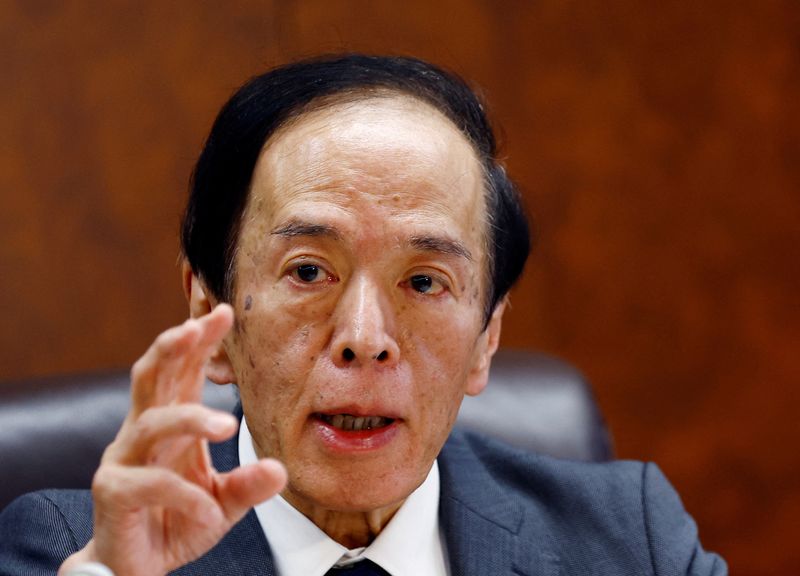Explainer-What will BOJ’s policy normalisation path look like?
2023.09.12 00:24

© Reuters. FILE PHOTO: Bank of Japan Governor Kazuo Ueda speaks at a group interview with media in Tokyo, Japan, May 25, 2023. REUTERS/Kim Kyung-Hoon/File Photo
By Leika Kihara
TOKYO (Reuters) – The Bank of Japan is under pressure to defend a new cap for long-term interest rates set just six weeks ago, as Governor Kazuo Ueda’s hawkish remarks heightened market expectations of a near-term end to its negative interest rate policy.
In an interview on Saturday, Ueda said the BOJ could have enough data by year-end to determine whether it can end negative rates, shocking markets that did not see such a move as imminent.
Below are the tools the BOJ is expected to use to combat sharp rises in bond yields, what happens next on monetary policy and factors that could determine the timing of a rate hike:
WHAT WOULD TRIGGER BOJ ACTION IN THE JGB MARKET?
After its forceful defence of a 0.5% cap drew criticism for distorting markets and fuelling an unwelcome yen fall, the BOJ tweaked its yield control policy in July to allow the 10-year Japanese government bond (JGB) yield to rise by up to 1%.
Ueda had described the 1% limit as a protective cap that likely won’t be hit any time soon given a fragile economy. But his hawkish remarks have pushed up the 10-year JGB yield to a near decade-high of 0.715% on Tuesday.
The BOJ will mainly focus on the speed of moves and step in, mainly through emergency bond buying operations, to curb sharp rises in yields, say sources familiar with its thinking. It also likely sees 0.8% as a threshold it wants to defend to avoid the 10-year yield from reaching 1%.
WHAT ABOUT OTHER ZONES OF THE YIELD CURVE?
The BOJ is also keen to prevent any sharp rise in yields for short- and medium-term notes, as they have a big impact on corporate borrowing costs.
To curb rises in the shorter end of the yield curve, it will offer two- or five-year loans against collateral to banks, a move aimed at encouraging investors to buy five-year bonds with loans carrying lower rates.
WHAT ARE KEY DATA AVAILABLE TOWARDS YEAR-END?
Inflation hit 3.1% in July, exceeding the BOJ’s 2% target for the 16th straight month. But the bank sees the increase as driven mostly by supply factors such as import costs, and wants more assurances that Japan will sustain 2% inflation underpinned by consumption.
The outlook of next year’s wages is therefore key. Japanese firms traditionally kick off their annual wage negotiations with unions in March. But some clues will be available this year.
Japan’s largest labour organisation Rengo will lay out in early December its target for next year’s wage hike, which will set the standard for wage talks between management and unions.
The BOJ will also scrutinise economic data and corporate earnings for clues on whether Japan’s recovery is strong enough to weather the hit from slowing global demand.
WHAT WILL HAPPEN NEXT?
If the BOJ is convinced Japan can sustain 2% demand-driven inflation, the next step is to ditch or hike a 0% target set for the yield, and raise short-term rates to zero from -0.1%.
There is no consensus within the BOJ on when and in what order it would dismantle the complex framework crafted under former Governor Haruhiko Kuroda. The bank’s staff is brainstorming various ideas that will be brought to the board for debate once conditions fall in place to exit ultra-loose policy.
Given Japan’s dire fiscal state, the priority would be to avoid an abrupt, sharp rise in long-term rates that boosts the cost of financing the country’s huge debt.
That could mean the BOJ will retain the yield cap as a precaution when it raises short-term rates, some analysts say.
WHEN WOULD BOJ NEXT SEND SIGNALS?
There are no scheduled public appearances of BOJ executives until governor Ueda’s regular news conference, to be held after the BOJ’s next two-day policy meeting ending on Sept. 22.
Japan’s August consumer price data is also due on Sept. 22.








